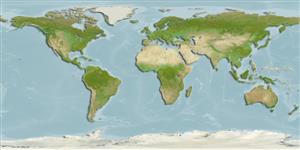>
Gobiiformes (Gobies) >
Gobiidae (Gobies) > Gobiinae
Etymology: Trimma: Greek, trimma, -atos = something crushed (Ref. 45335); burridgeae: Named for Mary Elizabeth Burridge (for her extensive work in the revisions of Priolepis, her ongoing work on barcoding Trimmaspp., her field collection in the Philippines and Vietnam, and her extensive contributions to the maintenance of the fish and frozen tissue collections at the Royal Ontario Museum)..
Environment: milieu / climate zone / depth range / distribution range
Écologie
marin; profondeur 4 - 50 m (Ref. 109919), usually 20 - 30 m (Ref. 109919). Tropical
Distribution
Pays | Zones FAO | Écosystèmes | Occurrences | Point map | Introductions | Faunafri
Western Pacific: Palau.
Taille / Poids / Âge
Maturity: Lm ? range ? - ? cm
Max length : 2.9 cm SL mâle / non sexé; (Ref. 109919)
Description synthétique
Morphologie | Morphométrie
Épines dorsales (Total): 7; Rayons mous dorsaux (Total): 8-9. This species is distinguished by the following characters: bony interorbital 80-100% pupil diameter; 11 scales in predorsal midline with the anterior few rows often cycloid in adults; the second dorsal spine reaches to between the middle and the end of the second dorsal fin or just beyond this point; usually four free neuromasts (sensory papillae) in row f on the chin and in row r on the top of the snout; usually 14 unbranched pectoral-fin rays; an unbranched fifth pelvic-fin ray that is 47-63% the length of the fourth ray; colour of freshly collected specimens red to yellow background colour with a light stripe along the mid-lateral body that continues forward over the top of the pupil, with a light stripe below the eye bordered dorsally by a narrow red stripe (both light stripes apparently blue in life), a broad diffuse internal dark stripe over the abdominal cavity which narrows and continues posteriorly on and just below the vertebral column, ending at the pale bar in front of the dark caudal blotch (Ref. 109919).
This species is apparently confined to outer reefs with vertical walls throughout the Palauan islands and is most abundant in caves and under overhangs between 20-30 m. It was collected from a huge cave (ca. 15 m wide, 4 m high) and surrounding area with sand/silt floor at 27 m, hydroids, some hard coral, sea fans, sponges and ascidians (Ref. 109919).
Life cycle and mating behavior
Maturité | Reproduction | Frai | Œufs | Fécondité | Larves
Winterbottom, R., 2016. Trimma tevegae and T. caudomaculatum revisited and redescribed (Acanthopterygii, Gobiidae), with descriptions of three new similar species from the western Pacific. Zootaxa 4144(1):001-053. (Ref. 109919)
Statut dans la liste rouge de l'IUCN (Ref. 130435)
Menace pour l'homme
Harmless
Utilisations par l'homme
Plus d'informations
PaysZones FAOÉcosystèmesOccurrencesIntroductionsStocksÉcologieRégime alimentaireÉléments du régime alimentaireConsommation alimentaireRation
Noms communsSynonymesMétabolismePrédateursÉcotoxicologieReproductionMaturitéFraiRassemblement de ponteFéconditéŒufsDéveloppement de l'œuf
Taille/ÂgeCroissanceLongueur-poidsLongueur-longueurFréquences de longueursMorphométrieMorphologieLarvesDynamique des populations larvairesRecrutementAbondanceBRUVS
RéférencesAquacultureProfil d'aquacultureSouchesGénétiqueElectrophoresesHéritabilitéPathologiesTraitementNutrientsMass conversion
CollaborateursImagesStamps, Coins Misc.SonsCiguateraVitesseType de nageSurface branchialeOtolithesCerveauxVision
Outils
Articles particuliers
Télécharger en XML
Sources Internet
Estimates based on models
Phylogenetic diversity index (Ref.
82804): PD
50 = 0.5000 [Uniqueness, from 0.5 = low to 2.0 = high].
Bayesian length-weight: a=0.00708 (0.00333 - 0.01504), b=3.09 (2.92 - 3.26), in cm total length, based on LWR estimates for this (Sub)family-body shape (Ref.
93245).
Résilience (Ref.
120179): Haut, temps minimum de doublement de population inférieur à 15 mois (Preliminary K or Fecundity.).
Fishing Vulnerability (Ref.
59153): Low vulnerability (10 of 100).
